GREAT SAND DUNES NATIONAL PARK
By the time we make our way through the mountains and into the enormous San Luis Valley there is no light left in the sky or on the road. Our headlights cut through the night to reveal only 50 feet of dead-straight asphalt, a few deer in the scrub by the side of the road, and the occasional kangaroo rat hopping to safety just in front of our tires. On Rt. 17 we had occasionally dimmed our headlights for oncoming traffic, but since turning towards the park on Lane 6 we encountered no other vehicles for the next 16 miles.
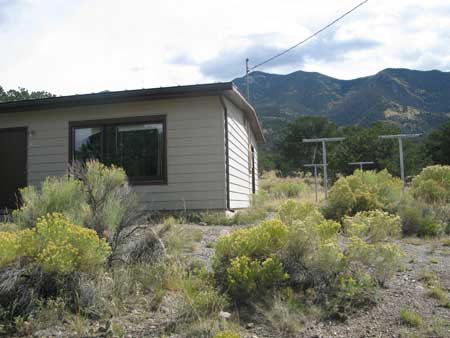
We take a left onto 150 and soon our lights pick out the solid adobe-style sign of Great Sand Dunes National Park, the only indication we have arrived. Otherwise we haven't a hint of what surrounds us. After a few miles a blinking red light marks the entry station. Patrick Myers, the ranger in charge of the Artist in Residence program, had told us to turn into the housing area, just before the station, he would leave a porch light on for us. We take the right marked Official Use Only - Resident Housing and a lone light beckons from a low 3-unit apartment building.
Doors are just not locked out here, so we let ourselves in and haul in our stuff. A quick look around reveals typically bland park housing--everything you need, without embellishment. We were glad to have it and and turn in, daylight will reveal our surroundings.
"You can see the dunes from here." It's sunrise and John is standing at the big front window.

I push aside the sleeping bag and join him to look out to a terrain of rabbit bush and pinon pines. In the gaps between the brushy pinons I can see the dunes. Now it feels like we're here.
We had made a stop at the closest grocery store on our route, the Sabilla Wallmart, 86 miles to the north. I make oatmeal and coffee in the narrow white kitchen, which is dominated by a huge refrigerator whose noisy motor woke me several times in the night. After breakfast we unpack our gear. There is plenty of storage in the studio apartment; 4 big closets, a particle-board shelving unit, big entertainment center with smoked glass doors with a lamp where the TV is meant to go. The only other furniture is a spindly folding table and 2 kitchen chairs, a double mattress on a metal frame, and a huge suede couch/recliner that looks like it belongs in a suburban TV room. I distribute my art materials on the shelves of the entertainment center, a tripod easel, a shoebox of oil pastels, a lidded pallette already filled with acrylic paint, watercolors, brushes, assorted pads and 20 ziploc bags, each containing assorted charcoal pencils and erasers for use in the charcoal sketching classes I will give next week.
Ready to explore, we hop in the little red rental car and head east for a drive through the park. It doesn't take long. The park road is only a few miles long, ending in campground loops.
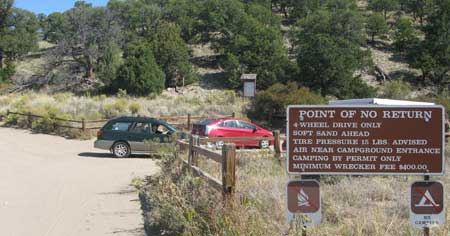
That's not remotely doable in our little car, so we double back to the visitor's center.
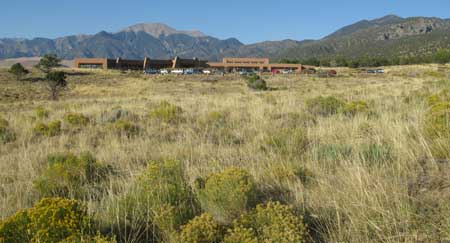
It's just before nine and there are half a dozen people waiting for it to open. We enter with them and meet some of the rangers. Even though I am the first to be an artist in residence in this park, they all seem to have heard of the program and give me a very friendly welcome and advice on exploring the park.
The guide books say to take a day or two to get acclimated to the high altitude before attempting strenuous activity. This is especially good advice in my case. I was trying to fight off a cold that had come on the day before we left, but my throat was now definitely sore and my sinuses blocked.
Which is why we decided to head out and climb to the highest elevation in the dunes — High Dune.
A few weeks earlier I had prepared for this trip by spending seven days climbing the dunes of Cape Cod, but the Great Dunes are higher by about 600 feet, the air is thinner by about 8000 feet. The climbing is steep and relentless - it takes me an hour to make the summit. Some of that time is spent with my toes dug into the steep slope like pitons, catching my breath and waiting for my heartbeat to return to normal.
This gives me time to examine the dune's surface. The sand color is different than the quartz/ochre of the dunes of Cape Cod. Here it is black speckled, light grey and rose, as well as much finer than I had imagined. In places it is so soft that I sink up of my calves, in others it is firm enough to support my weight. The toughest patches are those that at first support me, then break through just as I shift my weight to take the next step.

John goes ahead and waves from the summit at the top of one long last steep slope. When I finally join him I look around at a 360 view of the entire dune field. To the north the dunes are lower, their color fades to bleached ochre. Grass grows sparsely in the flat bottomed hollows.
To the northwest is Star Dune, the only other dune honored with a name on the park map. We consider hiking to it, but realize it's a lot further than it looks. We decide instead to walk along the top of the peaked walls to our west.
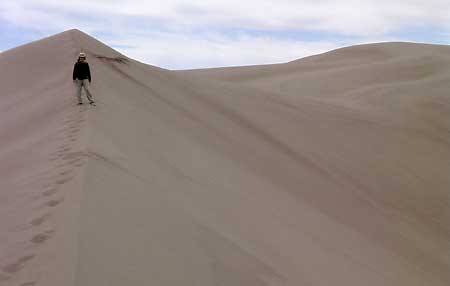
They look deceptively sharp and precarious, but the sand is fluid, so much so that our footprints turn the crisp edges into dotted lines and release slow pours of sand down their steep sides. The only challenge is deciding whether to walk slanting right, slanting left, or straddle the point in a sort of penguin walk, arms slightly lifted for balance. Even though I know the wind will soon rebuild the wall, I feel kind of bad that our footprints are dulling the perfect crisp edges, but I see the same shapes echoed more durably in the curves of the dark Sangre de Cristo Mountains.
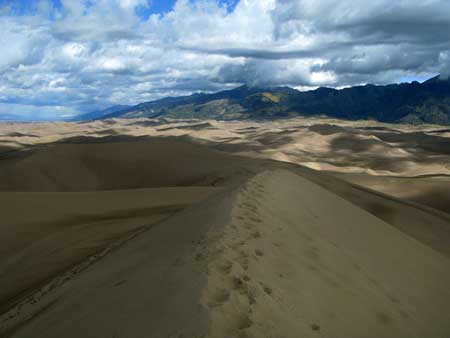
Now that we're up here, we're tempted to travel as long as we can along the ridges, but the weather has shifted. Clouds had been collecting overhead for awhile, their shadows swimming over the dunes. They now knit together and join with the dark and low clouds which hover over the mountains and start spitting raindrops. The wind has a sudden gritty bite, picking up the sand and driving it just over the dune's surface till it pours over the ridge, sandblasting it to smoothness before escaping into the air in a wild dance.
We make a quick decision to head straight down the dunes, sinking deep into the sand with each wide step, but making much better time than we did on the way up. As we reach the flat creek bed the rain is turning to a mixture of hail and snow. Time to take refuge in our little apartment.
[CONTINUED]